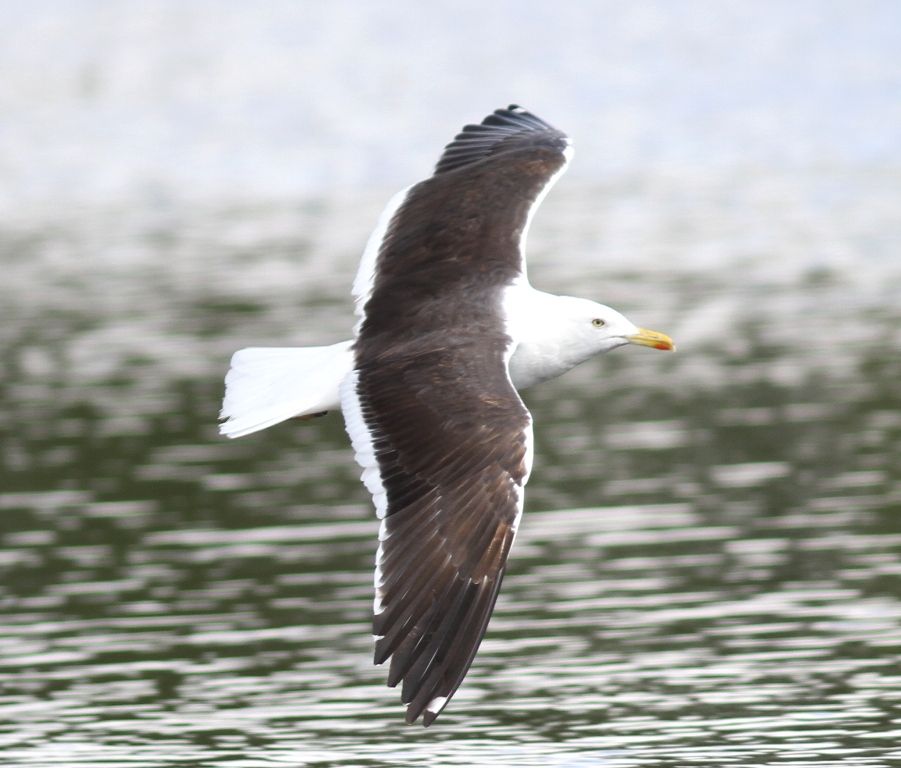How to separate fuscus and intermedius?
Okay. Finally I have started writing about fuscus gulls. So many gulls at Langvannet, and new individuals every day, so it has taken some time to get an overview of the different birds. I will in this post write mainly about the colorringed gulls from Nordland and how to separate them from intermedius, but will come back with rest of the fuscus-birds in a later post, and set them side by side to intermedius gulls. I have also been on the watch-out for graelsii. Have photos of far more graelsii-type birds than I have written about other places, so will probably make a post about them as well at the end.
So, lets start with the biggest problem when taking photos of Black-blacked gulls. The color on their backs changes with the light. Under you see the same individual one second apart.
 |
| J0LN (fuscus), from Sømna, in shadow |
 |
| J0LN, in sun, one second later |
In shadow the upperside appears dark and plain. In the sun on the other hand one can see that it actually have both old, worned feathers and new fresh ones.
 |
| fuscus-type |
 |
| fuscus-type |
Another individual, without ring on its leg. Even in the same light with the same settings on the camera, only a slight turn of its body can completely change the colors appearance.
This absolutely have to be taken into account when ID a fuscus outside its breading range. The darkness itself that is showed on photos can't be used as a characteristics by its own. Therefor we have to look for other clues.
To get a better grip on what to look for I have studied the two colorringed birds.
 |
| J0LN |
 |
| J1MU |
 |
| J1MU in flight |
When we know the age they are quite easy. A 2. summer intermedius or graelsii would not have looked like this, and since both birds are ringed as young in
Sømna, Nordland, Norway in 2010, it makes it a lot easier.
But, other birds in the field don't have an age-tag on them. So how can we separate 2. summer (3cy) fuscus and 3. summer intermedius (4cy)? I don't have the answer to that one, so I have tried to identify the subspecie before saying anything about the age.
Both J0LN and J1MU are quite advanced compared to literature. J1MU seems to have almost all black upperparts and 6 new primaries (Or are all of them changed? Looks different in flight and on ground). J0LN on the other hand have more brown feathers on upperpart, but have moulted 7 primaries. When you look at J0LN on the ground you will sometimes mistake it to be intermedius because of what looks like a lighter colored upperwing. Something that in fact are older, worned featers. Therefor, when trying to determine the upperwing color on subadult LBBG look after the new feathers!
 |
| JK9A, Vaterland 07.08 |
 |
| JK9A, Vaterland 14.05 |
This bird appears quite dark and fuscus like on my photo, but on Carsten Lomes ringing photo you can clearly see that it in fact is an intermedius. The bird was ringed in mid May, so it was probably much fresher then. If you look closely on my photo you can see the feature I am trying to get to... Have you spotted it yet?
Let me show you. Below I have compared JK9A (intermedius) and J0LN (fuscus)
 |
| (Have tried to make the two birds as similar exposed as possible) |
Many people would have sad that there are no differences between the two birds. Well, there is, but they are hard to spot. First of all JK9A is an adult bird, while J0LN is only subad. You can see that JK9A have moulted all primaries to adult feathers. J0LN have three feathers left. JK9A have a large window on P10, not something you want from your fuscus (even adult birds). J0LN also looks slightly longer-winged than JK9A. Looking at details in the wing, I find something interesting; J0LN seems to have old, brown feathers contrasting to darker new feathers, while JK9A have old, brown feathers and lighter new feathers. JK9A appears dark-winged with some paler spots, while J0LN appears pale-winged with some darker spots.
Summary
What can we say about fuscus vs intermedius by this?
An really long and elegant LBBG with dark upperside should get you start thinking and look for other characteristics. Lesser Black-backed Gull ssp. fuscus seems to often have only one small window on P10. Intermedius on the other hand often have a large window on even P9. The upperwing of fuscus in summer often has darker, new feathers in the wing, while intermedius has lighter, new feathers.
Still this is two subspecies that are incredibly similar, and only the most typical individuals or the one with known age and birthplace should be identified. I know that many people that looks at gulls on a daily bases never tries to identify fuscus outside the breeding area. Still I think some birds actually can be identified safely without a ring on its leg. We will come back to them!






































